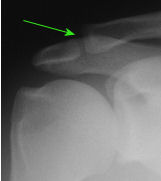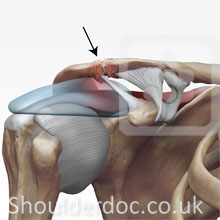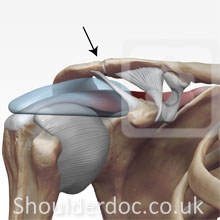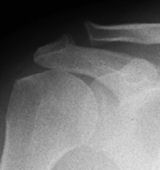ACJ Arthritis
Acromioclavicular Joint Arthritis of the Shoulder
WHAT IS IT?
Arthritis is a degenerative disease of a joint. Thus, arthritis of the AC joint is a degenerative disease of the acromioclavicular joint or AC joint.
As a person becomes older and uses the shoulder, normal wear and tear, or degeneration, of the cartilage takes place in the joint. There is a loss of cartilage and, over time, the joint can wear out, become larger, and develop spurs (spiny projections from the bone) around the joint. This degeneration results in a condition known as osteoarthritis. Similar to arthritis in other joints of the body, there is pain and swelling in the joint as it is used. AC joint arthritis—osteoarthritis of the acromioclavicular joint—is common in middle age.




Arthritic AC Joint on left image, compared with a normal AC joint on the right
CAUSES :
The principal cause of AC joint arthritis is use. As a person uses his/her arm and shoulder, stress is placed on the joint. This stress produces wear and tear on the cartilage, the cartilage becomes worn over time, and eventually arthritis of the joint may occur. Another cause is an old injury to the AC joint, such as ACJ Dislocation. Any activity that can put pressure on the joint, either normal or excessive, may eventually cause the arthritis condition.
Persons who must use their arms for extended periods of time are susceptible to AC joint arthritis. Constant overhead lifting, such as is engaged in by weightlifters or construction workers who work overhead, can increase the incidence of the disease. Other susceptible individuals are athletes participating in contact sports or engaging in any activity which may result in a fall on the end of the shoulder. Any blunt force to the shoulder in the course of work, household activities, or accident may cause, over time, an osteoarthritic condition of the AC joint.
TREATMENT:
1. Physiotherapy – to prevent any further stiffness and regain range of motion
2. Painkillers and anti-inflammatories
3. Injections into the painful joint - this usually provides good temporary relief.
4. Surgery – required for advanced disease, with pain not controlled with painkillers
Types of Surgery:
- ACJ Excision - removal of the AC joint. This may be done as an open procedure or arthroscopically (keyhole). We prefer to perform this arthroscopically.

Post-operative X-ray of an arthritic AC Joint, performed arthroscopically
PREVENTION:
- Keep doing as much of your normal routine as possible.
- Maintain a healthy weight
- Remain active to keep muscle strength from diminishing. If you work up to a well-designed exercise program, you can keep or even improve joint flexibility.
- Keep repetitive overhead activity to a minimum
- Rest only when joints are very painful.


